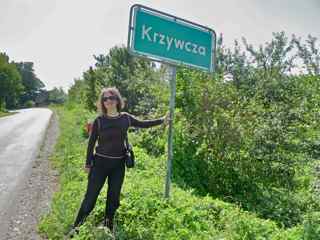|
Krzywcza
קשיוצ'ה
Poland
History
UNDER CONSTRUCTION
Historical Sources:
- Krzywcza
nad San - Polish text from: Słownik
geograficzny Królestwa Polskiego i innych krajów
słowiańskich, Tom IV, Warszawa : nakł.
Filipa Sulimierskiego i Władysława Walewskiego,
1880-1914, pp. 801-802.
English
Translation: forthcoming
Translation: Krzywcza.
a small town, district of Przemyśl,
court of distr. Dubiecko, district court
of Przemyśl, 168 meters
above sea level, 928 inhabitants, (19
km) Przemyśl Krzywcza n.
Sanem Babice n. Sanem Dubiecko.
Municipal Office. 1 Roman Catholic
church, 1 Greek Catholic church, 1
synagogue. Market or Fair: 15/1, 3/2,
4/3, 23/4, 6/5, 3/6, 24/6, 2/8, 21/9,
9/10, 11/11, 20/12.
****
- From:
Pinkas
HaKehillot
Polin (Encyclopedia of Jewish Communities,
Poland, vol. 3, Western Galicia):
"Krzywcza" (link to text forthcoming.)
Jewish
Population
|
Total
Population
|
Year
|
250
|
813
|
1880
|
250
|
941
|
1900
|
203
|
928
|
1921
|
****
Jewish Life in Krzywcza Between the
Wars
From Witness: Voices from the Holocaust,
edited by Joshua M. Greene and Shiva Kumar, New
York: The Free Press, 2000, p. 2-4. Edited from Joseph
W. Holocaust testimony, (HVT-2681).
[videorecording] interviewed by Dana L. Kline and
Susan Millen, September 21, 1994, New Haven Conn.:
Fortunoff Video Archive for Holocaust Testimonies,
1994.
Joseph
W.
Born
Przemyśl, Poland,
1922
Raised in Krzywcza, Poland |
The
small town of Krzywcza was, as is known in
the Yiddish vernacular as a shtetl
- a hundred Jewish families out a population
of two or three thousand. And they all
clustered around a central square. We lived
with my grandparents, who had a house, a
large house.
My mother was the
oldest daughter. She was the first one
married. My father had just come back from the
[first world] war. He was a soldier in the
Austrian army. I guess it was a shiddukh,
[which] means an arranged marriage, but they
knew each other. . . . I do remember going to
cheder, which was a Jewish school. And
boys, particularly, started at the age of
three Jewish instruction, especially reading,
learning the alphabet, and learning the
prayers, which was the most important. The
morning prayers, the Modeh Ani, which
means, "I thank you, God, for waking up and
being alive." Then the prayers before, making
the Motzi [prayer over bread] before
you ate anything.
My father had two
sisters living there. Their children, we were
very close. We knew each other -- houses all
around. And what I remember distinctly was a
certain spirit there, a spirit very Jewish,
deeply Jewish, religious, but custom,
traditional. The Sabbath, was the centerpiece
of the week. Starting Thursday, people
starting preparing for the Sabbath. The women
would prepare starting with the flour and the
baking. I remember my grandmother's house. My
mother was not [baking] because she was in
business. But my grandmother used to send
everything over. By my grandmother everything
was turned upside down. The stove was going. I
used to go Friday, and she had a little pletzl
there, a little piece of dough was left with
some onions, delicious. And the smells of the
baking! Thursday was the preparation, Friday
afternoon nobody did any more. The men went to
the mikvah [ritual baths] to get
themselves purified. The women started
preparing the children. So, it was certain, it
was a way of life that is - I don't know if
it's duplicated any place unless in the
Hasidic communities. But that was a way of
life that was the culmination of hundreds of
years of Jewish life in Eastern Europe. That
was the spirit in this little town.
The Sabbath was an
expression, it was a deep expression, made a
deep, deep impression on children. But the
outside world beckoned. We loved it, and we
wanted to break free. It was like a
tug-of-war. Then after the Sabbath, the
evening at the end of the Sabbath, was also a
feeling that you're losing something,
something very precious is passed. And you
prepared yourself for the week. So people had
to work. People had to make a living. You had
to go out to the villages. Either they bought
up produce or cattle or chicken, whatever, or
selling them in your stores. We had hardware
stores, textile stores. There were no
ready-made goods yet. Manufacturing was not
very well developed.
Ninety-nine percent
of our clientele was non-Jewish. People from
the surrounding villages used to come in and
buy. Of course it was tough. There was
competition. And they didn't have money, so
they paid in kind. They paid in eggs and
butter and potatoes, whatever. But somehow
this worked. This was right after the prayers
that separate, Havdalah service, which
is a separation between the holy and the
profane. The weekday was profane, the Sabbath
was the holy. So right after that people went
out, opened their stores because the peasants
were coming in, because Sunday was a big day.
This was how life
went. We were enveloped in this. The outside
world was only through the books, through
contact. But the contact with the peasantry
was not much. It was just the day-to-day. The
Jewish life was the essential.
|
Additional Sources:
- Zydzi w
Podkarpackiem by Andrzej Potocki,
Rzeszów: Libra, 2004, p. 86.
- History:
Krzywcza
- from Virtual
Shtetl. "Krzywcza," The
Encyclopedia of Jewish Life Before and
During the Holocaust, S. Spector, G.
Wigoder (eds.), Jerusalem: Yad Vashem; New York:
New York University Press, Vol. 2, (2001), 686.
This site is
hosted at no cost by JewishGen, Inc., the Home of
Jewish Genealogy. If you have been aided in your
research by this site and wish to further our
mission of preserving our history for future
generations, your JewishGen-erosity
is greatly appreciated.
|

